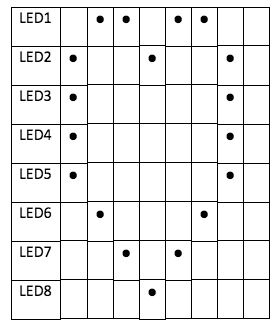Here's the pattern I drew but you can change it if you think you can draw one you like better, or you could do a smiley face or anything else you like. It worked best for me with 7 columns plus a blank one to turn the LEDs off.

The simplest way to do this is to code each column as a binary number, a 1 representing a LED on and a 0 for a LED off. (In C we write binary numbers starting "0b", so 3 in binary would be "0b11".)
So the first column will be 0b00011110, and the second will be 0b00100001. (We count the bits in a binary number from right to left, starting at zero, so bit 0, representing LED1, is 0 in the first column and 1 in the second.) Check you can see how I got that.
We store these binary numbers in an array called heart, which is simply a list of values. We declare it as having 8 elements and pre-set them like this:
int heart[8] = { 0b00011110, 0b00100001, … }
(We can put this before setup() after the other definitions, because we don't want it redefined every time loop() gets called.)
We can then refer to the first element as heart[0], the second as heart[1] and so on.
There's a function bitRead which extracts bit n (counting from zero at the right hand end) from a binary number. So bitRead(heart[0]) is 0, and bitRead(heart[1]) is 1.
Now HIGH and LOW as we usually write in digitalWrite are actually the same as 1 and 0, so we can directly use bitRead in a digitalWrite!
We're now ready to write our code. Let's display 3 hearts in red, green and blue. Here is the pseudocode:
For each colour:
For each row 0 - 7:
Wait a bit
Take the previous example (Pattern1), save it as Pattern2 and replace the code in loop() with your own. Now see if you can write the code.
Continue to Lesson 3 by clicking here!
If you're stuck try reading the Help Sheet!
